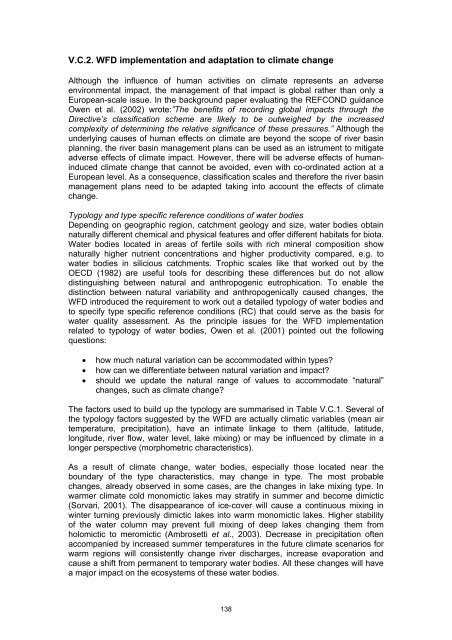Climate Change and the European Water Dimension - Agri ...
Climate Change and the European Water Dimension - Agri ...
Climate Change and the European Water Dimension - Agri ...
You also want an ePaper? Increase the reach of your titles
YUMPU automatically turns print PDFs into web optimized ePapers that Google loves.
V.C.2. WFD implementation <strong>and</strong> adaptation to climate change<br />
Although <strong>the</strong> influence of human activities on climate represents an adverse<br />
environmental impact, <strong>the</strong> management of that impact is global ra<strong>the</strong>r than only a<br />
<strong>European</strong>-scale issue. In <strong>the</strong> background paper evaluating <strong>the</strong> REFCOND guidance<br />
Owen et al. (2002) wrote:”The benefits of recording global impacts through <strong>the</strong><br />
Directive’s classification scheme are likely to be outweighed by <strong>the</strong> increased<br />
complexity of determining <strong>the</strong> relative significance of <strong>the</strong>se pressures.” Although <strong>the</strong><br />
underlying causes of human effects on climate are beyond <strong>the</strong> scope of river basin<br />
planning, <strong>the</strong> river basin management plans can be used as an istrument to mitigate<br />
adverse effects of climate impact. However, <strong>the</strong>re will be adverse effects of humaninduced<br />
climate change that cannot be avoided, even with co-ordinated action at a<br />
<strong>European</strong> level. As a consequence, classification scales <strong>and</strong> <strong>the</strong>refore <strong>the</strong> river basin<br />
management plans need to be adapted taking into account <strong>the</strong> effects of climate<br />
change.<br />
Typology <strong>and</strong> type specific reference conditions of water bodies<br />
Depending on geographic region, catchment geology <strong>and</strong> size, water bodies obtain<br />
naturally different chemical <strong>and</strong> physical features <strong>and</strong> offer different habitats for biota.<br />
<strong>Water</strong> bodies located in areas of fertile soils with rich mineral composition show<br />
naturally higher nutrient concentrations <strong>and</strong> higher productivity compared, e.g. to<br />
water bodies in silicious catchments. Trophic scales like that worked out by <strong>the</strong><br />
OECD (1982) are useful tools for describing <strong>the</strong>se differences but do not allow<br />
distinguishing between natural <strong>and</strong> anthropogenic eutrophication. To enable <strong>the</strong><br />
distinction between natural variability <strong>and</strong> anthropogenically caused changes, <strong>the</strong><br />
WFD introduced <strong>the</strong> requirement to work out a detailed typology of water bodies <strong>and</strong><br />
to specify type specific reference conditions (RC) that could serve as <strong>the</strong> basis for<br />
water quality assessment. As <strong>the</strong> principle issues for <strong>the</strong> WFD implementation<br />
related to typology of water bodies, Owen et al. (2001) pointed out <strong>the</strong> following<br />
questions:<br />
• how much natural variation can be accommodated within types?<br />
• how can we differentiate between natural variation <strong>and</strong> impact?<br />
• should we update <strong>the</strong> natural range of values to accommodate “natural”<br />
changes, such as climate change?<br />
The factors used to build up <strong>the</strong> typology are summarised in Table V.C.1. Several of<br />
<strong>the</strong> typology factors suggested by <strong>the</strong> WFD are actually climatic variables (mean air<br />
temperature, precipitation), have an intimate linkage to <strong>the</strong>m (altitude, latitude,<br />
longitude, river flow, water level, lake mixing) or may be influenced by climate in a<br />
longer perspective (morphometric characteristics).<br />
As a result of climate change, water bodies, especially those located near <strong>the</strong><br />
boundary of <strong>the</strong> type characteristics, may change in type. The most probable<br />
changes, already observed in some cases, are <strong>the</strong> changes in lake mixing type. In<br />
warmer climate cold monomictic lakes may stratify in summer <strong>and</strong> become dimictic<br />
(Sorvari, 2001). The disappearance of ice-cover will cause a continuous mixing in<br />
winter turning previously dimictic lakes into warm monomictic lakes. Higher stability<br />
of <strong>the</strong> water column may prevent full mixing of deep lakes changing <strong>the</strong>m from<br />
holomictic to meromictic (Ambrosetti et al., 2003). Decrease in precipitation often<br />
accompanied by increased summer temperatures in <strong>the</strong> future climate scenarios for<br />
warm regions will consistently change river discharges, increase evaporation <strong>and</strong><br />
cause a shift from permanent to temporary water bodies. All <strong>the</strong>se changes will have<br />
a major impact on <strong>the</strong> ecosystems of <strong>the</strong>se water bodies.<br />
138













